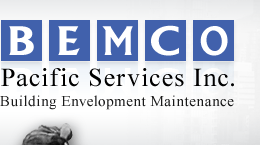

 |
 |
|
 |
 |

|

|
 |
 |
|
Menu
|
Why Should I Do Maintenance on Building ExteriorsBuilding inspection and maintenance is a relentless endeavor, a job that never ends. Regardless of the design, or materials used, all assemblies require maintenance in order to realize their full service life potential. Your building exterior operates in a harsh environment, and must deal with UV exposure, airborne contaminants, and wind driven rain and snow. The maintenance of building exteriors has long been recognized as an important factor in a structures overall performance. It is referred to in the British Columbia Homeowner Protection Act as a requirement of the buildings owners, as well as a condition of the prescribed warranties. The following excerpt from CSA S478-95 Guidelines on Durability in Buildings outlines the benefits of a maintenance program. "For given materials and constructions exposed to identical loads, the design service lives for similar buildings are adjusted depending on the amount and nature of maintenance that the owners commit to carry out during the lives of the completed buildings." Maintenance is defined in this document as "The actions and measures taken periodically to maintain a desired level of performance. Maintenance includes a planned program of cleaning, repair, or replacement of identified components such as paint or gaskets." The following analogy is from the "Best Practices Guide Wood Frame Envelopes in the Coastal Climate of British Columbia" published by CMHC. "The concept of maintenance and renewals planning for an envelope assembly is very analogous to the life of automobile tires. Tires will provide 80,000 kms of reliable service if regular care is given to inflation pressure, alignment and abnormal hazards (operations and maintenance). After 80,000 kms tires will continue to perform, although if inspected there will be much less tread and the walls will show signs of cracking. Continued use of the worn tires carries with it well known risks. Risks range from the inconvenience and cost of a flat tire, to that of injury and loss of life as a result of losing control of the vehicle at the time of failure. Prudent automobile owners replace tires at the end of their useful life, and avoid exposure to unacceptable risks (renewals). The building exterior is the exposed portion of a wall system, whose function is the separation of interior and exterior environments. Your exterior maintenance program should address the following areas.
As outlined above, it is important to appreciate the various factors that affect the long term durability of building components. All building operations should be considered for their impact on the durability of building materials. While some buildings do not fall under the jurisdiction of the Homeowner Protection Act, the exclusions as outlined in the act provide a guide as to a prudent level of care expected of all owners. Permitted exclusions – defects 11 A warranty provider may exclude any or all of the following items from home warranty insurance: (e) any damage to the extent that it is caused or made worse by an owner or third party, including (i) negligent or improper maintenance or improper operation by anyone other than the A failure to deal with maintenance items in a timely manner can result in damage to other building components, both interior and exterior. A proactive approach to monitoring and maintaining the building exterior will prolong the service life of the building components, and avoid premature deterioration. Eliminating premature failures of building components protects your investment, and preventing problems is far more cost effective than reacting to and repairing them.
|
|